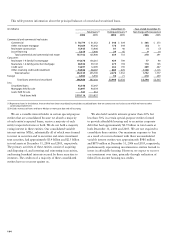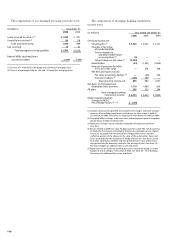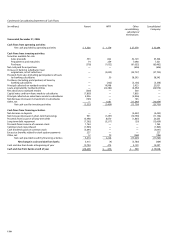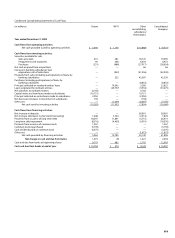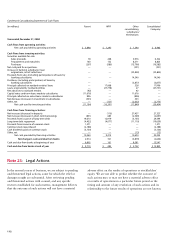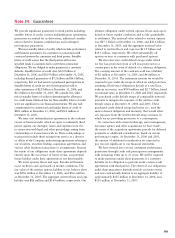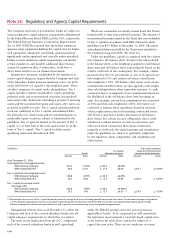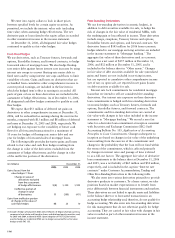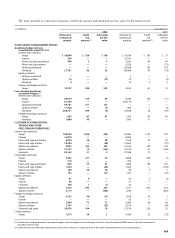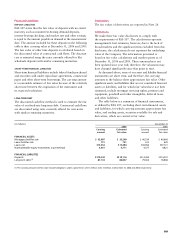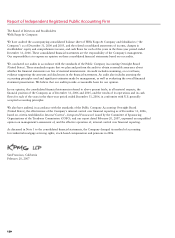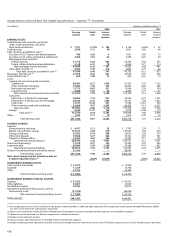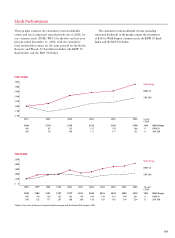Wells Fargo 2006 Annual Report Download - page 115
Download and view the complete annual report
Please find page 115 of the 2006 Wells Fargo annual report below. You can navigate through the pages in the report by either clicking on the pages listed below, or by using the keyword search tool below to find specific information within the annual report.
113113
Note 24: Guarantees
We provide significant guarantees to third parties including
standby letters of credit, various indemnification agreements,
guarantees accounted for as derivatives, additional consider-
ation related to business combinations and contingent
performance guarantees.
We issue standby letters of credit, which include performance
and financial guarantees, for customers in connection with
contracts between the customers and third parties. Standby
letters of credit assure that the third parties will receive
specified funds if customers fail to meet their contractual
obligations. We are obliged to make payment if a customer
defaults. Standby letters of credit were $12.0 billion at
December 31, 2006, and $10.9 billion at December 31, 2005,
including financial guarantees of $7.2 billion and $6.4 billion,
respectively, that we had issued or purchased participations in.
Standby letters of credit are net of participations sold to
other institutions of $2.8 billion at December 31, 2006, and
$2.1 billion at December 31, 2005. We consider the credit
risk in standby letters of credit in determining the allowance
for credit losses. Deferred fees for these standby letters of credit
were not significant to our financial statements. We also had
commitments for commercial and similar letters of credit of
$801 million at December 31, 2006, and $761 million at
December 31, 2005.
We enter into indemnification agreements in the ordinary
course of business under which we agree to indemnify third
parties against any damages, losses and expenses incurred
in connection with legal and other proceedings arising from
relationships or transactions with us. These relationships or
transactions include those arising from service as a director
or officer of the Company, underwriting agreements relating to
our securities, securities lending, acquisition agreements, and
various other business transactions or arrangements. Because
the extent of our obligations under these agreements depends
entirely upon the occurrence of future events, our potential
future liability under these agreements is not determinable.
We write options, floors and caps. Periodic settlements
occur on floors and caps based on market conditions. The
fair value of the written options liability in our balance sheet
was $556 million at December 31, 2006, and $563 million
at December 31, 2005. The aggregate written floors and caps
liability was $86 million and $169 million, respectively. Our
ultimate obligation under written options, floors and caps is
based on future market conditions and is only quantifiable
at settlement. The notional value related to written options
was $47.3 billion at December 31, 2006, and $45.6 billion
at December 31, 2005, and the aggregate notional value
related to written floors and caps was $11.9 billion and
$19.5 billion, respectively. We offset substantially all
options written to customers with purchased options.
We also enter into credit default swaps under which
we buy loss protection from or sell loss protection to a
counterparty in the event of default of a reference obligation.
The carrying amount of the contracts sold was a liability
of $2 million at December 31, 2006, and $6 million at
December 31, 2005. The maximum amount we would be
required to pay under the swaps in which we sold protection,
assuming all reference obligations default at a total loss,
without recoveries, was $599 million and $2.7 billion, based
on notional value, at December 31, 2006 and 2005, respectively.
We purchased credit default swaps of comparable notional
amounts to mitigate the exposure of the written credit
default swaps at December 31, 2006 and 2005. These
purchased credit default swaps had terms (i.e., used the
same reference obligation and maturity) that would offset
our exposure from the written default swap contracts in
which we are providing protection to a counterparty.
In connection with certain brokerage, asset management,
insurance agency and other acquisitions we have made,
the terms of the acquisition agreements provide for deferred
payments or additional consideration, based on certain
performance targets. At December 31, 2006 and 2005,
the amount of additional consideration we expected to
pay was not significant to our financial statements.
We have entered into various contingent performance
guarantees through credit risk participation arrangements
with remaining terms up to 23 years. We will be required
to make payments under these guarantees if a customer
defaults on its obligation to perform under certain credit
agreements with third parties. The extent of our obligations
under these guarantees depends entirely on future events
and was contractually limited to an aggregate liability of
approximately $125 million at December 31, 2006, and
$110 million at December 31, 2005.



